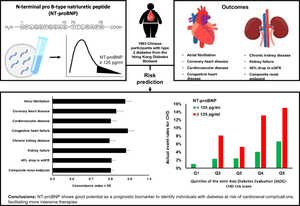Diabetologia ( IF 8.4 ) Pub Date : 2024-11-07 , DOI: 10.1007/s00125-024-06299-x Ronald C. W. Ma, Claudia H. T. Tam, Yong Hou, Eric S. H. Lau, Risa Ozaki, Juliana N. M. Lui, Elaine Chow, Alice P. S. Kong, Chuiguo Huang, Alex C. W. Ng, Erik G. Fung, Andrea O. Y. Luk, Wing Yee So, Cadmon K. P. Lim, Juliana C. N. Chan

|
Aims/hypothesis
N-terminal pro B-type natriuretic peptide (NT-proBNP) is a natriuretic peptide that is strongly associated with congestive heart failure (CHF). The utility of NT-proBNP for prediction of cardiovascular events and renal endpoints, compared with clinical risk factors, has not been evaluated in detail. We hypothesise that NT-proBNP can improve risk stratification and prediction of cardiorenal events in type 2 diabetes, beyond that provided by clinical risk factors.
Methods
NT-proBNP was measured in 1993 samples from the Hong Kong Diabetes Biobank, a multicentre prospective diabetes cohort and biobank. A cut-off of ≥125 pg/ml was used to define elevated NT-proBNP. Associations between elevated NT-proBNP and incident cardiovascular and renal endpoints were examined using Cox regression, adjusted for sex, age and duration of diabetes, as well as other covariates. Prognostic and incremental predictive values of NT-proBNP in diabetes cardiorenal complications, compared with those of the Joint Asia Diabetes Evaluation risk equations for CHD, CHF and kidney failure, were evaluated using the concordance index (C index), net reclassification improvement index, integrated discrimination improvement index and relative integrated discrimination improvement index.
Results
A total of 24.7% of participants had elevated NT-proBNP. Participants with elevated NT-proBNP at baseline had a more adverse cardiometabolic profile, with 2–4-fold higher frequency of complications at baseline. Adjusting for age at baseline, sex and duration of diabetes, elevated NT-proBNP was associated with incident atrial fibrillation (HR 4.64 [95% CI 2.44, 8.85]), CHD (HR 4.21 [2.46, 7.21]), CVD (HR 3.32 [2.20, 5.01]) and CHF (HR 4.18 [2.18, 8.03]; all p<0.001). All these associations remained significant after further adjustment for additional covariates. Elevated NT-proBNP had good discriminative ability for various cardiorenal endpoints, with C index of 0.83 (95% CI 0.76, 0.90) for CHD, 0.88 (0.81, 0.94) for atrial fibrillation, 0.89 (0.83, 0.95) for CHF, 0.81 (0.77, 0.84) for 40% drop in eGFR and 0.88 (0.84, 0.92) for kidney failure. Models incorporating NT-proBNP had improved prediction compared with established clinical risk models. Sensitivity analyses including alternative cut-off of NT-proBNP, as well as use of other risk engines of CHD, yielded similar results.
Conclusions/interpretation
NT-proBNP demonstrated a promising ability to serve as a prognostic marker for a variety of cardiorenal complications in type 2 diabetes. Considering NT-proBNP in clinical assessments could potentially help identify high-risk individuals who may benefit from more intensive therapies.


















































 京公网安备 11010802027423号
京公网安备 11010802027423号